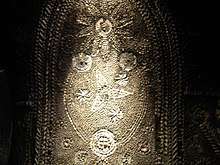Shell grotto

A shell grotto is a type of folly, a grotto decorated with sea shells.
History
The shell grotto was a popular feature of British country house in the 17th and 18th centuries. It arose from the influence of the Rococo style (which used swirling motifs similar to sea shells)[1] and mimicry of architectural features from the Italian renaissance (themselves copies from Classical times). The idea of a grotto was originally a means to enhance a dank undercroft, or provide an antechamber before a piano nobile, but later became a garden feature independent of the house. Early grottos were mainly of the shell grotto type, mimicking a sea-cave, or in the form of a nymphaeum; later there was a move towards more naturalistic cave-like grottoes.[1]
The first recorded shell grotto in England was at Whitehall Palace; James I had it built in the undercroft of the Banqueting House in 1624, but it hasn't survived. Two years later the Duke of Bedford had a shell room built at Woburn Abbey, featuring shell mosaics and carved stone. This, and another at Skipton Castle, built in 1627, are the only surviving examples from the 17th century.[1]
Shell grottoes were an expensive luxury: The grotto at Oatlands Park cost £25,000 in 1781 and took 11 years to build; and at Fisherwick Park the Marquess of Donegall spent £10,000 on shells alone in 1789.[2] The Grotto at Margate has 2000 square feet of mosaic, using some 4.6 million shells.
By the end of the 18th century fashion had moved on to more naturalistic cave-like structures, before falling out of favour altogether. Many were demolished or have fallen into disrepair, but some 200 grottos of all types are known to have survived in some form in the UK.[1]
Examples
- Shell Grotto, Margate, an example in Margate, Kent, England
- Shell Grotto, Pontypool, another in Pontypool, Wales
- Scott's Grotto, a shell grotto in Ware, Hertfordshire, England
- The Shell Room at Woburn Abbey, the earliest surviving 17th-century shell grotto[3]
- The east tower of Skipton Castle's gatehouse contains a 17th-century shell grotto
- Shell Grotto, Nienoord, a treasury at the Nienoord estate in Leek, Netherlands
- The Shell Grotto at Château de Vendeuvre
- The Shell-lined grotto at Goldney Hall, Bristol, England
- The Shell Grotto at Endsleigh Cottage, England
- Headley-Whitney Museum, in Lexington, Kentucky, US where a former three car garage was transformed into a shell grotto
- The Shell House in Terrington, N Yorkshire UK
- The former Paua House in Bluff, New Zealand, now partly re-created at Canterbury Museum, Christchurch
- Shell-covered gardening sheds in Grosvenor Gardens, London